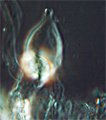Więc dostałem od Piotrka dwie płytki z elektroniczną publikacją Baral'a (Zotto 2003) - może być legalnie rozprowadzane (taka jest zgoda autora opisane we wstępie).
Robi wrażenie i niewątpliwie wymaga głebszego zapoznania się niż te 30 minut które narazie poświeciłem.
Baral propaguje namiętnie obserwację żywego materiału - i podnosi wagę różnych cech które w suszkach giną - jak zauważa sarkastycznie (CD1, katalog Einfuhrung - Introduction, plik Introduction.doc):
"Of course, herbarium specimens must be made, but to work with them should be avoided whenever possible. This is our longlasting experience,
hard to bear for a herbarium taxonomist."
podkreślenie moje :) - hm :)
czyli w wolnym tłumaczeniu:
"Oczywiście, trzeba robić suszki ale należy unikać ich oglądania kiedy tylko się da.
[uwaga moja: dalej będzie piękna figura retoryczna - pluralis majestaticus plus niepodważalny cios autorytetu]
Opieramy się na naszym wieloletnim doświadczeniu trudnym do udzwignięcia dla zielnikowych taksonomów"
Prorokowi wołającemu na puszczy należy wiele wybaczyć :) tym bardziej że:
Poniższe fotki z
Baral, Zotto 2003/CD1/Morphology/Vital vs. dead/LBS
Po co o tym piszę, ano idąc tym tropem dogrzebałem się ilustracji która tłumaczy, być może, dziwne septowane twory z tego wątku:

"LEFT: Living spores in water. Note multiguttulate lipid pattern and free nuclear region (some spores are aseptate, with one central nucleus, others are 1- or 3-septate, with several nuclei. RIGHT: Dead in water (shortly heated in dry state over a flame). Septa become visible, lipid bodies fuse and fill the whole cell."
A to poniżej ilustruje wagę rodzaju i ułożenia kropelek oleistych jako cechy diagnostycznej dla gatunków:

inny przykład nawiązujący do naszych wiosennych rozważań o czarkach:
ważna wg. Barala cecha - układ kropli oleistych - jest widoczna tylko u żywych Sarcoscypha jurana, u martwych zawartość komórki ulega dezorganizacji

"Ascospores shot on slide. 6 living (clearly biguttulate, wider) and 4 dead spores"
Ma rację. Tylko jak organizacyjnie znaleźć czas na takie podejście :) kiedy rosną grzyby ledwo czas na teren, kiedy zima to są już suszkami.




